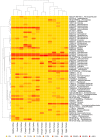The Bacterial Microbiome of Meloidogyne-Based Disease Complex in Coffee and Tomato
- PMID: 32174936
- PMCID: PMC7056832
- DOI: 10.3389/fpls.2020.00136
The Bacterial Microbiome of Meloidogyne-Based Disease Complex in Coffee and Tomato
Abstract
The Meloidogyne-based disease complexes (MDCs) are caused by the interaction of different root-knot nematode species and phytopathogenic fungi. These complexes are devastating several important crops worldwide including tomato and coffee. Despite their relevance, little is known about the role of the bacterial communities in the MDCs. In this study 16s rDNA gene sequencing was used to analyze the bacterial microbiome associated with healthy and infested roots, as well with females and eggs of Meloidogyne enterolobii and M. paranaensis, the causal agents of MDC in tomato and coffee, respectively. Each MDC pathosystems displayed a specific taxonomic diversity and relative abundances constituting a very complex system. The main bacterial drivers of the MDC infection process were identified for both crops at order level. While corky-root coffee samples presented an enrichment of Bacillales and Burkholderiales, the corcky-root tomato samples presented an enrichment on Saprospirales, Chthoniobacterales, Alteromonadales, and Xanthomonadales. At genus level, Nocardia was common to both systems, and it could be related to the development of tumor symptoms by altering both nematode and plant systems. Furthermore, we predicted the healthy metabolic profile of the roots microbiome and a shift that may result in an increment of activity of central metabolism and the presence of pathogenic genes in both crops.
Keywords: Meloidogyne enterolobii; Meloidogyne paranaensis; corky root; functional profile; pathobiome.
Copyright © 2020 Lamelas, Desgarennes, López-Lima, Villain, Alonso-Sánchez, Artacho, Latorre, Moya and Carrión.
Figures






Similar articles
-
First report of Meloidogyne javanica on Ginger and Turmeric in the United States.J Nematol. 2019;51:1-3. doi: 10.21307/jofnem-2019-006. J Nematol. 2019. PMID: 31088018 Free PMC article.
-
Susceptibility of Seven Caladium (Caladium × hortulanum) Cultivars to Meloidogyne arenaria, M. enterolobii, M. floridensis, M. incognita, and M. javanica.J Nematol. 2017 Dec;49(4):457-461. J Nematol. 2017. PMID: 29353935 Free PMC article.
-
First Report of Meloidogyne enterolobii on Cotton and Soybean in North Carolina, United States.Plant Dis. 2013 Sep;97(9):1262. doi: 10.1094/PDIS-03-13-0228-PDN. Plant Dis. 2013. PMID: 30722442
-
First Report of the Root-Knot Nematode Meloidogyne enterolobii Infecting Jujube in China.Plant Dis. 2014 Oct;98(10):1451. doi: 10.1094/PDIS-04-14-0370-PDN. Plant Dis. 2014. PMID: 30704003
-
Major emerging problems with minor meloidogyne species.Phytopathology. 2013 Nov;103(11):1092-102. doi: 10.1094/PHYTO-01-13-0019-RVW. Phytopathology. 2013. PMID: 23777404 Review.
Cited by
-
Bacteria as Biocontrol Tool against Phytoparasitic Nematodes.Plants (Basel). 2021 Feb 18;10(2):389. doi: 10.3390/plants10020389. Plants (Basel). 2021. PMID: 33670522 Free PMC article. Review.
-
Rhizosphere Engineering of Biocontrol Agents Enriches Soil Microbial Diversity and Effectively Controls Root-Knot Nematodes.Microb Ecol. 2024 Sep 28;87(1):120. doi: 10.1007/s00248-024-02435-7. Microb Ecol. 2024. PMID: 39340684 Free PMC article.
-
Metagenomic Approach Deciphers the Role of Community Composition of Mycobiome Structured by Bacillus velezensis VB7 and Trichoderma koningiopsis TK in Tomato Rhizosphere to Suppress Root-Knot Nematode Infecting Tomato.Microorganisms. 2023 Sep 30;11(10):2467. doi: 10.3390/microorganisms11102467. Microorganisms. 2023. PMID: 37894125 Free PMC article.
-
Plant-parasitic nematode disease complexes as overlooked challenges to crop production.Front Plant Sci. 2024 Jul 23;15:1439951. doi: 10.3389/fpls.2024.1439951. eCollection 2024. Front Plant Sci. 2024. PMID: 39109062 Free PMC article. Review.
-
Molecular and Environmental Triggering Factors of Pathogenicity of Fusarium oxysporum and F. solani Isolates Involved in the Coffee Corky-Root Disease.J Fungi (Basel). 2021 Mar 27;7(4):253. doi: 10.3390/jof7040253. J Fungi (Basel). 2021. PMID: 33801572 Free PMC article.
References
-
- Albuquerque E. V. S., Carneiro R. M. D. G., Costa P. M., Gomes A. C. M. M., Santos M., Pereira A. A., et al. (2010). Resistance to Meloidogyne incognita expresses a hypersensitive-like response in Coffea arabica. Eur. J. Plant Pathol. 127, 365–373. 10.1007/s10658-010-9603-3 - DOI
-
- Alvarado J. A. (1935). Tratado de Caficultura Práctica (Guatemala: Tipografia Nacional; ).
-
- Anderson M. J., Walsh D. C. I. (2013). PERMANOVA, ANOSIM, and the Mantel test in the face of heterogeneous dispersions: What null hypothesis are you testing? Ecol. Monogr. 83, 557–574. 10.1890/12-2010.1 - DOI
-
- Anderson M. J. (2001). A new method for non-parametric multivariate analysis of variance. Austral Ecol. 26, 32–46. 10.1111/j.1442-9993.2001.01070.pp.x - DOI

